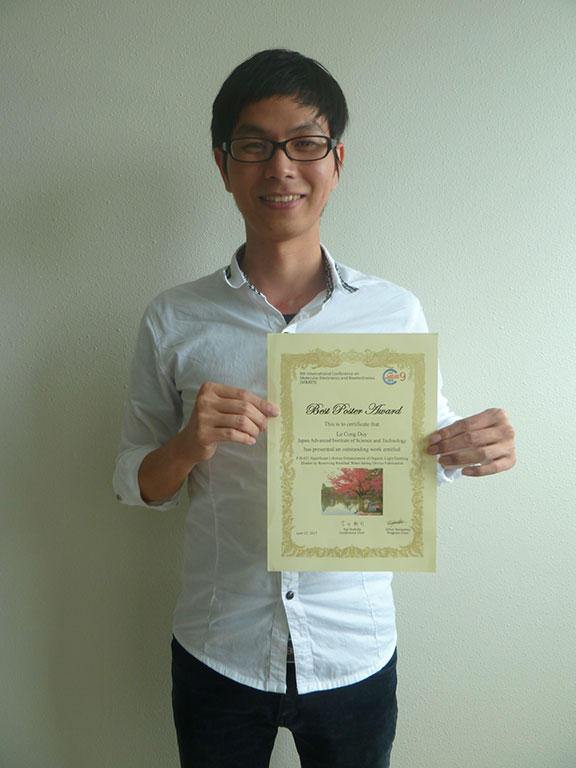Mr.Le Cong Duy, Applied Physics Area, received the Best Paper Award in The 9th International Conference on Molecular Electronics and Bioelectronics.
Mr.Le Cong Duy,2nd year master's student in Murata lab. of Applied Physics Area, received the Best Paper Award in The 9th International Conference on Molecular Electronics and Bioelectronics.
The 9th International Conference on Molecular Electronics and Bioelectronics (M&BE9) has been organized by the Japan Society of Applied Physics (JSAP) since 2001. Topics of this conference are basic studies such as fabrication and characterization of thin films, interfacial phenomena, spectroscopy, and single-molecule manipulations, as well as application-oriented studies, related to LEDs, FETs, solar cells, memory devices, biochips, biosensors.
There were 224 authors in the poster session and 14 authors were selected for the Best Paper Award.
■Date Awarded
June 27, 2017
■Title
Significant Lifetime Enhancement of Organic Light Emitting Diodes by Removing Residual Water during Device Fabrication.
■Abstract
The degradation of Alq3-based organic light emitting diodes (OLEDs) can be attributed to the residual gas striking to substrates during the fabrication process. In this study, to further evacuating the residual gas in an evaporation chamber, non-evaporable getters (NEG) pumps were added along with tandem turbo molecular pumps (TMPs). We demonstrate fivefold and twofold enhancement in the short- and long-term stability of the device fabricated with a combination of TMPs and NEGs, respectively. Surprisingly, almost no change in operation voltage in the OLED-NEG after the 500 h operation was observed. This suggests that voltage increase due to charge trapping is not the origin of either the short-term or long-term degradation of Alq3-based OLEDs.
■Comment
I'm honored to receive the Best Poster Award in 9th International conference Molecular Electronics and Bioelectronics (M&BE9, Kanazawa 2017). It was such a great opportunity for me not only to get updated the latest research in my field of organic light emitting diodes, but also to broaden my view to other interesting fields such as bioelectronics and solar cells. I would like to express my gratitude to Prof. Hideyuki Murata and Asst. Prof. Heisuke Sakai for their constant supervision. In addition, thanks to all members in Murata laboratory for always being collaborative and supportive.

July 7,2017
